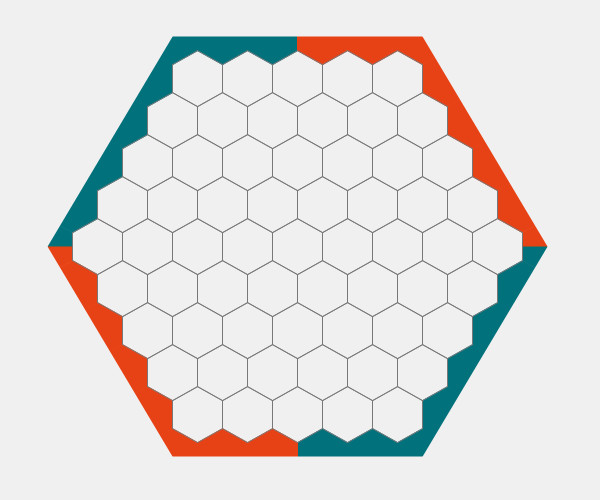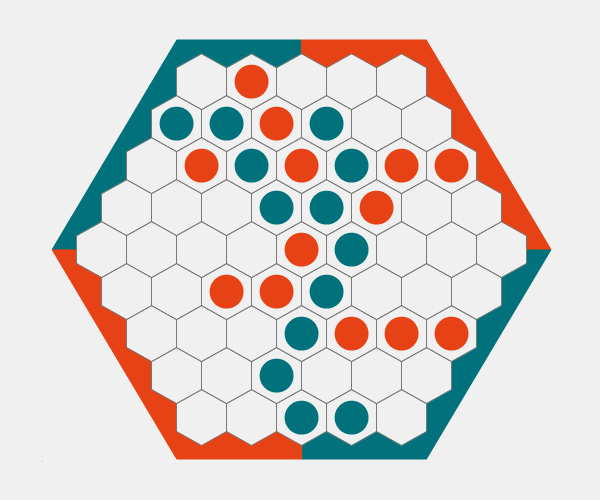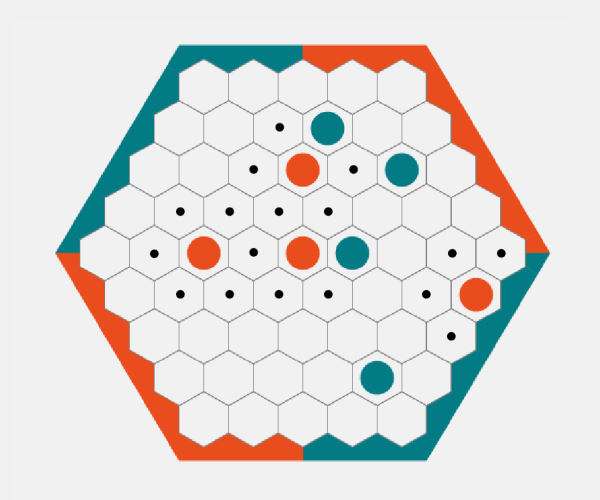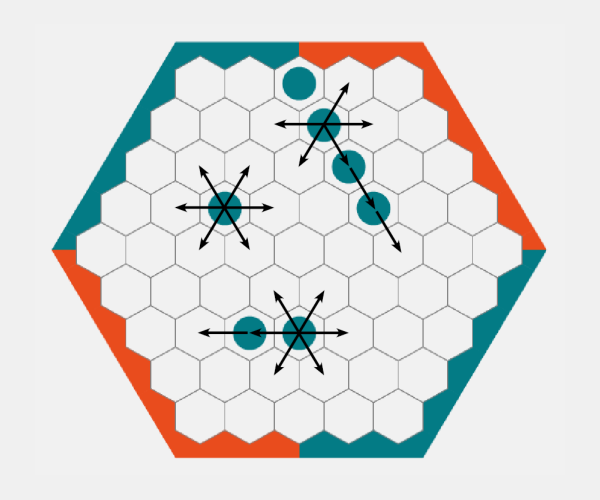Flecks is an abstract board game for two players. The goal of the game is, as in Hex, to make a connection between opposite sides of the board. In Flecks, unlike in Hex, stones may be moved during the game.
The board and the stones
Flecks is played on a board made up of hexagons, which itself is a large hexagon. The border of the board is divided into four parts, two opposite sides are marked red, the remaining two are marked blue. (The colors used in the examples are actually more like orange and turqoise, but for convenience we’ll call them red and blue.) The regular board size has seven fields on each border. Advanced players may choose a board of size nine. For learning purposes the game can be played on a size five board. (In the examples on this site, the learning board is used.)
One of the players is using red stones, the other blue.
The basic idea of the game
Both players in turn put a stone on the board and move a row of their stones. Both player try to make a connection between the opposite sides of their own color. For example, the red player has won when the red stones make a connection between the opposite red sides. In the game shown below, blue has won.
Two phases
The game is divided into two phases. In the first, stones are put on the board and no stones may be moved. In the second phase, stones are put on the board with the restriction that they must be adjacent to a stone of the same color, and in addition stones may be moved.
The initial phase
In the first phase both players in turn put one of their stones on an empty field of choice. This is repeated a couple of times. How many stones are put on the board depends on the size of the board. On the regular board of size seven, the initial phase ends when both players have four stones on the board. In the smaller learning board of size five, the players each add two stones to the board. In the larger board of size nine, it is six stones.
The red player starts. On the first stone this player puts on the board there is a restriction. The first stone of red must be put on the outer ring, that is, next to the border. In this way, the advantage of beginning is counterbalanced.
After the initial phase
In the second phase of the game, the players are allowed to perform two actions in each move:
- First, the player may add a stone to the board. This must be done on an empty field adjacent to a stone of the same color. In the example blow, the possible position to add a stone for red are shown.
- Then, the player is allowed to move a row of his stones. A row is formed by a number of adjacent stones on a single line. A row may only be moved in the direction of the row itself. The row may only be moved to unoccupied fields. The row may be moved as far as the length of the row itself or less. Thus, for example, a row of two stones may be moved either one or two fields. A row of three stones may be moved one, two or three fields. A single stones forms a row as well (of length one), which may be moved a single step. It is allowed to split a row in a move. For example, if a row has length three, two of the stones may also be moved, as far as two fields. In the image below, for three stones the legal moves are indicated with arrows.
The end of the game
The player creating a closed chain between opposite sides of his color has won. The chain does not have to be a straight line, but it has to be connected.
Often made mistakes
To avoid confusion, here is a list of illegal moves:
- You can never remove or strike stones from the board.
- After the initial phase, you cannot add stones on a field of choice. You have to put it next to one of your stones on the board.
- You cannot move a row in another direction than the direction of the row itself. In other words, you cannot move a row ‘around a corner’.
- In the second phase of the game the players are allowed to move stones on the board, but they don’t have to. The moving may be skipped.
Remarks on the game
One of the charming features of the Flecks, as in Hex, is that it can never result in a draw. When the board is completely filled with stones, one of the players will have completed a winning connection. Any connection with one color will block the connection of the other, and there is just one way of completely blocking the enemy, and that is to make a complete connection yourself. Try to check this fact for yourself. If you have fully grasped it, your understanding of the game will be better.
If an illegal move is pointed out to you (by another player or by the computer), don’t be disappointed. Any player will make that kind of mistakes in the struggle to get through to the game. If you have played a couple of games, the moving will get to feel very naturally.



